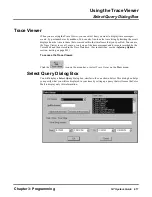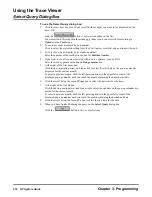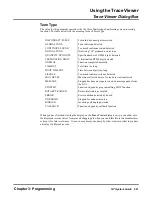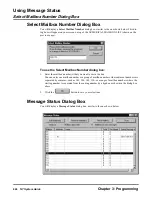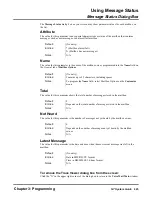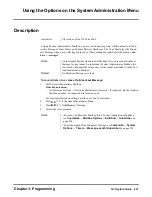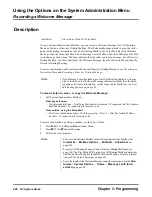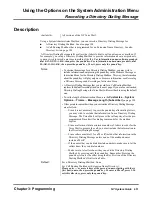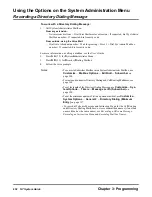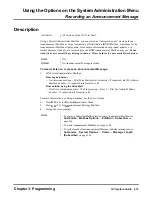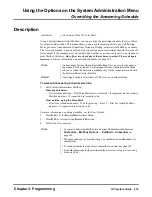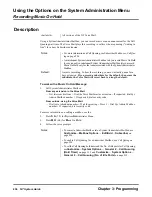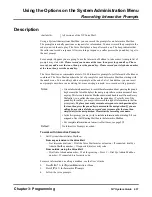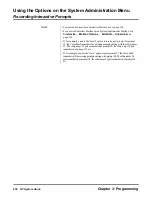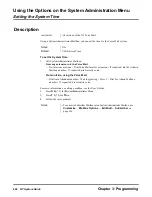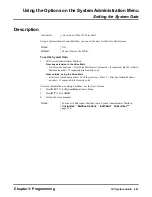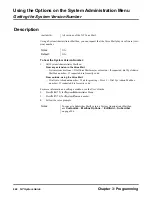
Using the Options on the System Administration Menu
Recording a Directory Dialing Message
Chapter 3: Programming
NT System Guide
431
Recordi ng a Dir ectory Diali ng Messag e
Description
Using a System Administrator Mailbox, you can record a Directory Dialing Message for:
O
A Directory Dialing Mailbox. See also page 194
O
A Call Routing Mailbox that is programmed for an Extension Name Directory. See also
Directory List on page 190.
A Directory Dialing Message tells a caller what letters to dial to call an extension or mailbox. If,
for example, you set up a Directory Dialing Mailbox to provide information about new products,
you may wish to record a message something like this: For information on new software products,
dial S-O-F-T-W-A-R-E, then press the pound key. For information on hardware products, dial
H-A-R-D-W-A-R-E, then press the pound key. To exit, press only the pound key.
Availability:
All versions of the NT Voice Mail.
Notes:
• To shorten the message for a Directory Dialing Mailbox, you may wish to
include information about pressing the pound key in the Welcome Message or
Instruction Menu for the Directory Dialing Mailbox. This way, the information
about the pound key will play only once. For more information, see Recording
a Welcome Message and Recording an Instruction Menu .
• A Directory Dialing Message that you record for a Call Routing Mailbox
replaces the default recording listed on the next page. If you erase a customized
Directory Dialing Message, the Voice Mail will revert back to using the default
one.
• To set the length of the Instruction Menu, use the
Customize
¿
System
Options
¿
Timers
¿
Message Length (Subscriber)
on page 328.
• Other points to remember when you customize a Directory Dialing Message
are as follows:
— Since it is not necessary to press the pound key after dialing letters,
you may wish to exclude that information from a Directory Dialing
Message. The Voice Mail will process the call anyway after the pre-
programmed Time limit for dialing commands for the mailbox
expires.
— Since a caller must dial a minimum number of letters in order for the
Voice Mail to process the call, you must include that information in
the Directory Dialing Message.
— Since callers must dial 1 for a
Q
or
Z,
include that information in the
Directory Dialing Message unless none of the mailbox names
include a
Q
or
Z
.
— If the names that can be dialed include numbers, make sure to let the
callers know they can dial numbers.
— Make sure to let callers know they can exit the Directory Dialing
Mailbox by pressing only the pound key. Remember: Pressing the
pound key reroutes the caller using the Key 0 Action of the Directory
Dialing Mailbox's Dial Action Table.
Default:
For a Directory Dialing Mailbox: None
For Call Routing Mailboxes (Extension Name Directory):
Please enter — or more letters of the person's name, starting with their
first (last) name, then press the pound key. To enter a
Q
or
Z
, press 1. To
exit this directory, press only the pound key.
Summary of Contents for NVM-NT
Page 28: ...Table of Contents Chapter 5 Maintenance xxvi NT System Guide ...
Page 130: ...Installing SMDI 102 NT System Guide Chapter 3 Programming ...
Page 146: ...Customizing Caller I D Tables General Tab 118 NT System Guide Chapter 3 Programming ...
Page 156: ...Customizing Callout Options Optional Tab 128 NT System Guide Chapter 3 Programming ...
Page 182: ...Customizing Distribution Lists General Tab 154 NT System Guide Chapter 3 Programming ...
Page 338: ...Customizing Port Options General Tab 310 NT System Guide Chapter 3 Programming ...
Page 358: ...Customizing System Options Timers Tab 330 NT System Guide Chapter 3 Programming ...
Page 362: ...Customizing System Options Timers Tab 334 NT System Guide Chapter 3 Programming ...
Page 367: ...Customizing Tenant Options General Tab Chapter 3 Programming NT System Guide 339 ...
Page 396: ...Viewing and Printing Reports System Options Report 368 NT System Guide Chapter 3 Programming ...
Page 400: ...Performing a Local Backup Backup Dialog Box 372 NT System Guide Chapter 3 Programming ...
Page 440: ...Using Port Activities 412 NT System Guide Chapter 3 Programming ...
Page 454: ...Using Message Status Message Status Dialog Box 426 NT System Guide Chapter 3 Programming ...

